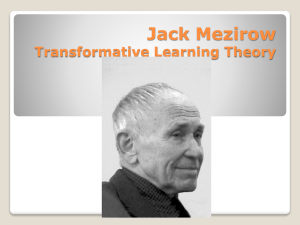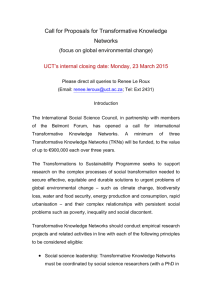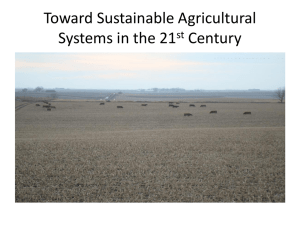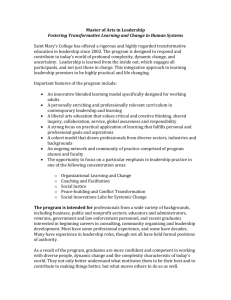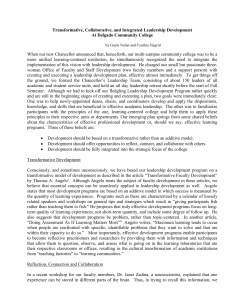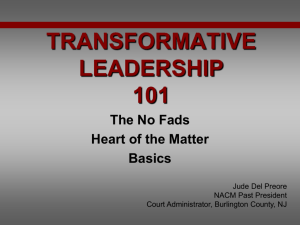Transformative Design for Change
advertisement
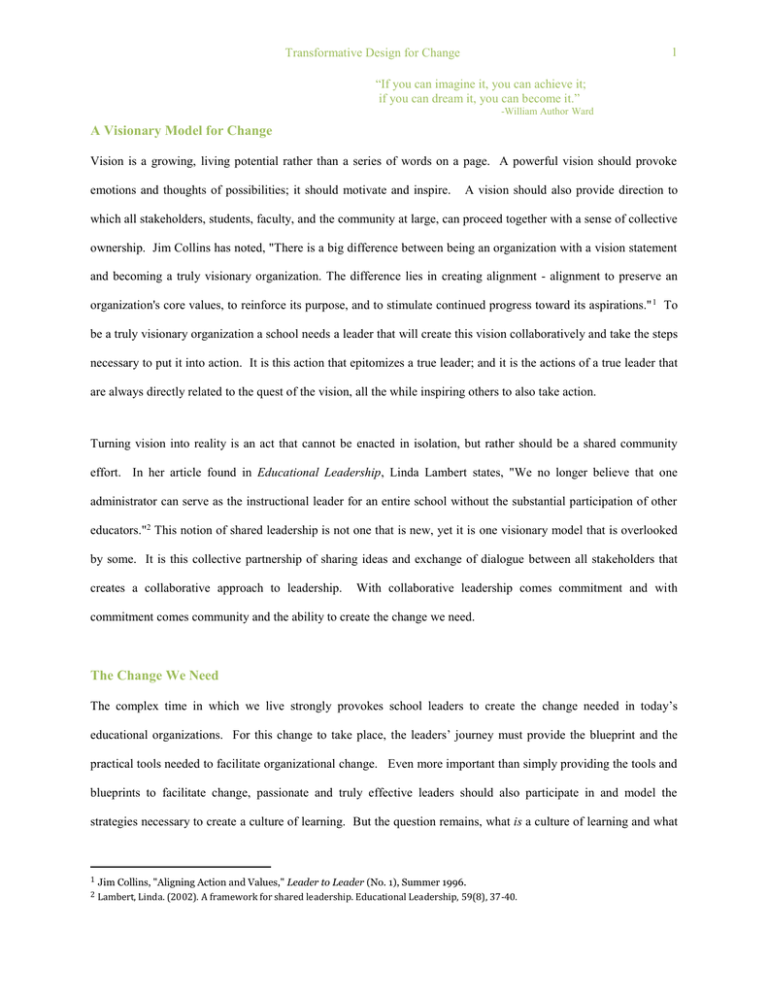
1 Transformative Design for Change “If you can imagine it, you can achieve it; if you can dream it, you can become it.” -William Author Ward A Visionary Model for Change Vision is a growing, living potential rather than a series of words on a page. A powerful vision should provoke emotions and thoughts of possibilities; it should motivate and inspire. A vision should also provide direction to which all stakeholders, students, faculty, and the community at large, can proceed together with a sense of collective ownership. Jim Collins has noted, "There is a big difference between being an organization with a vision statement and becoming a truly visionary organization. The difference lies in creating alignment - alignment to preserve an organization's core values, to reinforce its purpose, and to stimulate continued progress toward its aspirations." 1 To be a truly visionary organization a school needs a leader that will create this vision collaboratively and take the steps necessary to put it into action. It is this action that epitomizes a true leader; and it is the actions of a true leader that are always directly related to the quest of the vision, all the while inspiring others to also take action. Turning vision into reality is an act that cannot be enacted in isolation, but rather should be a shared community effort. In her article found in Educational Leadership, Linda Lambert states, "We no longer believe that one administrator can serve as the instructional leader for an entire school without the substantial participation of other educators."2 This notion of shared leadership is not one that is new, yet it is one visionary model that is overlooked by some. It is this collective partnership of sharing ideas and exchange of dialogue between all stakeholders that creates a collaborative approach to leadership. With collaborative leadership comes commitment and with commitment comes community and the ability to create the change we need. The Change We Need The complex time in which we live strongly provokes school leaders to create the change needed in today’s educational organizations. For this change to take place, the leaders’ journey must provide the blueprint and the practical tools needed to facilitate organizational change. Even more important than simply providing the tools and blueprints to facilitate change, passionate and truly effective leaders should also participate in and model the strategies necessary to create a culture of learning. But the question remains, what is a culture of learning and what 1 2 Jim Collins, "Aligning Action and Values," Leader to Leader (No. 1), Summer 1996. Lambert, Linda. (2002). A framework for shared leadership. Educational Leadership, 59(8), 37-40. Transformative Design for Change 2 change is needed to ensure that our educational institutions create a culture of learning that exemplifies academic rigor, high performance and integrity in the people it serves (including all stakeholders - students, faculty, and the community at large) to help them achieve their potential; all the while placing high importance on one’s ability to use strategies that allow them to gain access to curriculum and true learning. In addition to creating people who are able to succeed with regards to learning, curriculum and prescribed standards, it is the duty of the school organization to create citizens that are critical and creative thinkers, who are able to communicate effectively through their listening, speaking, and writing, who are able to collaborate with others to learn and resolve conflicts, who can set personal learning goals and prioritize and organize the steps needed to reach those goals, who can manage time effectively, while in tandem extending their own learning to become masters of the ever changing world in which our society now exists. Stakeholder Involvement Transforming a school organization takes leadership, commitment and time. It also requires the support of [all] stakeholders.3 But, how can school leaders ensure that these stakeholders have the ability to participate in the development and realization of a shared vision? In her school reform research L.A. Blair states that, “The process of spreading the vision, is however, less dependent on the articulateness and persuasiveness of the individual than on his or her willingness to structure opportunities for all interested [stakeholders] to discuss their aspirations for the change program and the school, and to be patient in trusting that [all stakeholders] will take on the collective responsibility for refining the vision through shared action.” 4 It is also observed that, “Visions become strong not because faculty believe in the principal, but because they believe in themselves and their ability to really change schools for the better.” School communities that are committed to this task must entrust their educators to help their students. Turning Shared Vision into Reality – Nurturing Growth Needed for Success In crafting and articulating a vision for what I feel the schools of today should be, imagine a tree with strong roots, trunk and branches from which many leaves grow. This metaphor of the tree as a living, breathing entity serves as 3 Am e r i c a n A s s o c i a t i o n o f S c h o o l Ad m i n i s t r a t o r s . ( 2 0 0 8 ) . T h e Tr a n s f o r m a t i o n o f P u b l i c S c h o o l s . R e t r i e v e d ( 2 0 1 0 , M a r c h 2 1 ) f r o m h t t p : / / w w w. a a s a . o r g / u p l o a d e d F i l e s / R e s o u r c e s / f i l e s / N S O Y F o r u m 4 B l a i r, L . A . ( 2 0 0 0 ) . S t r a t e g i e s f o r S u c c e s s : Im p l e m e n t i n g a c o m p r e h e n s i v e s c h o o l r e f o r m p r o g r a m . R e t r i e v e d ( 2 0 1 0 , M a r c h 2 1 ) f r o m h t t p : / / w w w. s e d l . o rg / p u b s / c h a n g e 4 6 / Transformative Design for Change 3 a more readily conceived representation of the transformative change needed today as our educational organizations are also living entities that are ever changing. To more fully express this metaphor, imagine first the roots, which serve to anchor the tree, absorbing water and nutrients from the soil - in a sense nurturing the tree. These roots serve as the foundation needed for visionary change to take place. Imagine these roots to be the supports necessary to facilitate this change and give it life. These roots or strategic foundations for change, expressed categorically are connecting, advocating, programming, and development. From these roots, rising from the ground is the trunk, strong yet malleable. This trunk is the child or the students, which our educational organizations support. This trunk is ever impressionable and able to be shaped and carved into and continues to grow over many years. This trunk is also resilient as it is able to bend and sway in response to the storms of development. Each branch full of leaves, extends from the trunk representing the many facets of knowledge that our students gain throughout their years of academic, physical, social, and emotional development. As they grow, their branches grow and their leaves spread out in many directions, as does their quest for knowledge and learning. From this, is created the tree’s canopy from which we can see our students’ achievements, strengths, weaknesses, and their progress growing upward toward the sky. . From this metaphorical image of child as tree comes the undisputed strategic goal of all educational institutions - to promote student growth as learners. How educational communities nurture the growth that supports this learning is greatly varied. Districts, in collaboration with all educational stakeholders, including administration, faculty and staff members, parents, students, and the community at large provide the supports needed so that every student can achieve his or her maximum potential. These collaborative efforts are the nutrients, which feed district goals and structures that in turn allow schools and the communities in which they symbiotically exist to grow and flourish. Creating Connections – Planting the Seeds Within the ever-changing society in which we now live lies a dramatically different world in which our students and their families exist. The many changes of family roles and structures in recent times provokes us to create the change needed to support and grow the students which we serve within our educational systems. “Healthy child development requires strong, nurturing families that in turn are nurtured and supported by individuals and institutions within the Transformative Design for Change 4 community.”5 As a result, family-school relationships are becoming increasingly important. If all stakeholders are to become allies that together serve to raise student achievement, each of these groups must be able to communicate. “Yet parents rarely have forums where they can speak openly with educators [and] educators rarely have opportunities to talk with representatives of community organizations. Establishing ways in which all people can communicate and share in improving education can only help.”6 The communication between schools and families must improve considerably to be able to provide adequate supports that today’s families need to help their children – our children, achieve. Such supports include providing all educational stakeholders, parents, educational institutions and community members alike, the ability to participate in open forums of discussion involving such issues as the need for transformative change in our educational systems and the action steps required to set into motion such change. Given this, an effective and truly visionary leader must be able to communicate his or her vision in such a way that creates buy in. Visionary leaders must communicate their vision for transformative change clearly and passionately to the public, as it is the passion that is equally important at the vision for change that is contagious. Community members and parents especially must be taught how they can become more informed and educated about how to take part in such dialogue. The insert on the following page from the U.S. Department of Education, outlines tips for promoting cross-stakeholder communication about education issues. Tips for Promoting Cross-Stakeholder Communication About Education Issues Convene groups of diverse stakeholders from across the state to discuss, get trained, and network about issues related to parent involvement in children's education. At the school level, bring together parents, teachers, and students to discuss key education issues of importance and interest to them. Facilitate workshops that help parents understand how to identify and ask the important questions regarding the education of their children that they need answered. 5 B a s t o w We i s s , H . , & H a r v a r d F a m i l y r e s e a r c h P r o j e c t , In i t i a l s . ( E d . ) . ( 2 0 0 5 ) . P re p a r i n g e d u c a t o r s t o i n v o l v e f a m i l i e s : f ro m t h e o r y t o p r a c t i c e . T h o u s a n d O a k s , C A: S a g e . 6 U.S. Department of Education, Office of Innovation and Improvement, Engaging Parents in Education: Lessons From Five Parental Information and Resource Centers, Washington, D.C., 2007. Transformative Design for Change 5 U.S. Department of Education, Office of Innovation and Improvement, Engaging Parents in Education: Lessons From Five Parental Information and Resource Centers, Washington, D.C., 2007. In addition to educating parents about the potential they have in taking part in transformative educational forums, opening the lines of communication between teachers and administrators with regards to both their child’s academic concerns and successes is equally important. This communication provides parents, especially those who may not be very involved with their child’s educational experience for one reason or another, a venue in which they can express their thoughts concerning their child, be they current family circumstances or background information concerning a specific situation. Communication with parents at times does not only serve to support the student, but rather the parent. Forming honest and trusting relationships with parents allows them the ability to also seek your support with regards to their child in times they are in need as well. These lines of communication not only act to inform parents, but also act as a vehicle to allow parents the ability to be informed and empowered to allow them to more actively contribute to their child’s education. “When parents and educational institutions create goals and a shared vision for their child and collaboratively agree upon the strategies upon which to act, everyone benefits. Researchers and practitioners have documented for some time how schools and communities working toward common goals can be beneficial.”5 At a much more grass roots level, supports within the school setting for students involve teachers, administrators and other faculty members simply communicating and making personal connections with children. The simple act of engaging a student in conversations about things that really matter to them – personal interests or academics, can help to increase student confidence and sense of self. Children need close relationships with adults to help advocate for them and assist them sort through issues related to social and emotional development. Teachers are the most likely adults that children will encounter and if given the supports to explore themselves and the world around them, they can thrive. With collaborative efforts such as the simple examples outlined above of opening lines of communication between teachers and parents and teachers and students, educating parents about how to be more actively involved and engaged in their child’s learning and educational careers, and creating community forums in which all stakeholders may contribute, educational institutions, families, and the communities in which they symbiotically exist can Transformative Design for Change 6 provide a more promising future for their young citizens. Research on successful school reform highlights, “The power of the inclusive educational family in making all students successful learners. Everyone who might possibly come into contact with a student is a partner in ensuring that student's academic success.”7 For this mind-set to become a reality in an educational community, communication networks amongst all stakeholders are vital. Planting the Seeds of Change Inherent principles, or standards of decision making, of transformative change and shared leadership are the blueprints or action steps that must be set into place to allow for this change to come to fruition. First and foremost, the truly visionary leader must carefully craft the culture for change. Leadership is a complex being. It not only involves communicating visionary change in a clear, concise and truly passionate way, or the ability to include all stakeholders in engaging dialogue concerning the issues related to educating children in today’s world, but it also involves advocating for what you truly believe in and who you truly believe in. To be a truly effective leader one must wear many shoes to be able to walk the walk – not just talk the talk. Outstanding leaders cannot only serve to enlighten and motivate their faculty and staff, but they must also act as the biggest fan, the confidant and most importantly as the advocate. Having the willingness to actively listen, support, and participate in dialogue with teachers when they are willing to take risks and share innovative ideas is essential for shared leadership to become truly shared. Additionally, allowing those around you to know that they can feel safe in being able to think outside the box to create and share their possible solutions for complex problems is essential. And equally as important is the ability to consider and explore new and innovative ideas and model for others that taking risks can lead to successful outcomes, even if you know that you may fail, all for the ultimate purpose of knowing that what we do is our passion and is in the hope that our students learn. Each of these elements is essential, but allowing teaching staff the time and monies needed to develop and support programs and curricula with the goal of student engagement and achievement in mind is absolutely critical. 7 Laura Lein, Ph.D.; Joseph F. Johnson Jr., Ph.D.; Mary Ragland, Successful Texas School Wide Programs: Research Study Results, The Charles A. Dana Center, The University of Texas at Austin, Austin, Texas, February 1997. Transformative Design for Change 7 In addition to creating a culture of change, a culture that shares leadership responsibilities, a culture of advocacy, and a culture of risk taking, are the clearly articulated horizontal and vertical action steps needed to create visionary change. These action steps include a collaborative community that develops innovative curriculum, instructional strategies, and assessment to ensure all students reach their maximum potential. A well organized scheduling matrix that supports this curriculum and programming therefore is key. Additionally, using ongoing formative and summative assessment tools to redesign and adapt instruction that ensures quality learning is imperative. Data from these assessments is then to be used as a tool for making improvements and informing decision regarding strengths and weakness in the curriculum. Crafting curriculum and programming that not only supports student learning, but also acts to engage students in learning that they deem as important and valuable to their lives is essential. In addition to creating the curriculum and programming that will support transformative change in our schools we must ensure that our faculty and staff are current with innovative pedagogy and research related to their field, are knowledgeable about best practices, and feel secure in their understanding about doing what is best for kids. Staff development, in this sense then, is another area of shared leadership. The use of a peer coaching model is a powerful way to help administrators and teachers incorporate new instructional strategies and skills that meet the needs of all learners into their daily work. Allowing for scheduling and staffing options that allow teachers to visit other teacher’s classrooms to observe “things that work,” such a discipline models, executive functioning strategies, or time management systems is of great value to staff. Additionally, offering peer coaching from learning specialists within the building by means of modeling “live” lessons for students during classes will allow for teachers to learn from each other and create small, informal professional learning communities where they can learn to identify successful practices. Many teachers feel that having a coach makes it easier to transfer new techniques and skills into their classroom teaching repertoire. Peer coaching allows for colleagues to not only build upon knowledge and skill set, but is also builds mutual respect among participants. Exemplary learning communities develop and grow stronger over a period of many years, as does the metaphorical tree that must bend and sway in the storms of development in order to continue to gain strength and thrive. Visionary change is not, and cannot be instantaneous rather; its growth is slow and deliberate, reaching ever Transformative Design for Change 8 upwards. Educational leaders, working collaboratively with faculty and staff members, students, parents, and community members must together, work hard to plant, feed, and maintain their trees and build the sense of stewardship that is necessary to strengthen our school communities and ensure that all students are able to take root and grow.


